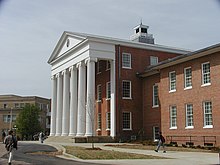Lyceum-The Circle Historic District

Lyceum - The Circle Historic District is a monument -region in Oxford , Mississippi , the eight buildings and several other structures at the University Circle on the campus of the University of Mississippi includes. Also known as Ole Miss , the college was established as the state's premier institution , and the leading Mississippi families sent their sons and daughters here to study.
The district is historically significant for its association with the 1960s civil rights movement , led by African-Americans , and the growing role the federal government played in promoting change. In Mississippi, there was both official and private opposition to the judicial desegregation of the university in the fall of 1962. The confrontation between the two sides resulted in the intervention of the US federal government to ensure the safety of citizens. Ole Miss was incorporated through the enrollment of James Meredith on October 1, 1962, which sparked riot. It was declared a National Historic Landmark on October 7, 2008 (although it was not announced until October 14).
Objects of the district
Located in the middle of the Ole Miss University campus, the protected historic district includes eight academic buildings on University Circle, which encloses an area commonly known as The Circle . These eight structures are the Lyceum Building , the Old Chemistry Building , the Croft Institute for International Studies, and the Carrier, Shoemaker, Ventress, Bryant, and Peabody dormitories. The district also includes the flagpole in the middle of the circle, the Confederate Monument, and the University Circle itself.
The Lyceum Building was the only academically used structure in the early days of the university and included a lecture hall, several classrooms, faculty offices, a geological museum and the library. Today the university administration is located there. The building, built in 1848, is the oldest structure on campus.
The Circle is circled by the University Circle, a one-way street. The green area is covered with trees and lawn. A metal flagpole stands in the center of the green area and serves as the starting point for the various walkways that run through the green area. Since the mid-19th century, the Circle has been the center of the historic core of the Ole Miss University campus.
The flagpole (German flagpole ) has been in the middle of the circle since 1962. The brick foundation was added in 2000. During the riot, a former college football player climbed the pole to get the rioters' attention and persuade them to go home.
The Confederate Monument has stood since 1906 with a sculpture reminiscent of a castle and with the inscription "To Our Confederate Dead, 1861-1865, Albert Sidney Johnston Chapter 379 UDC" and the figure of a Confederate soldier armed with a rifle who entered the Distant sees.
The University Circle is a 17 m wide roundabout with exits between the Y building and Bryant Hall and on either side of the Lyceum, giving access to the other areas of the university campus.
The Old Chemistry Building was built in 1923. During the riot of September 30, 1962, students broke into the building, made Molotov cocktails, and threw them at civilian and federal vehicles parked around the circle.
The Carrier Hall was one of several buildings that searched the students on the material to use it in the riots. Connected to the two-story main wing by two covered passages is a rear building, which is also two-story, but slightly narrower than the main building.
The four-story Shoemaker Hall was under construction at the time of the 1962 riot. The students used bricks, iron pipes and a bulldozer to attack the federal officials. One of the two riot victims died here.
The two-story Ventress Hall was built in 1889 and can be seen in a popular photo by James Meredith of the semester's opening parade on August 18, 1963.
The Croft Institute for International Studies , known as the "Y Building" during the desegregation and even earlier as the Old Chapel, sheltered many who fled tear gas and the general chaos in 1962. In the building, many watched President John F. Kennedy's televised address on the desegregation at Ole Miss.
From 1911 to 1952, Bryant Hall was home to the university library and has since housed the Fine Arts Center. During the riots, much of the street battles took place in front of the building.
During the riot, Peabody Hall was a safe place from tear gas. When faculty member Russell Barrett was cut off inside the building, he documented the unrest.
Individual evidence
- ↑ a b Interior Designates 16 New National Historic Landmarks ( English ) In: DOI News Release . US Department of the Interior. October 14, 2008. Archived from the original on October 20, 2008. Info: The archive link was automatically inserted and not yet checked. Please check the original and archive link according to the instructions and then remove this notice. Retrieved November 3, 2008.
- ↑ a b Gene Ford and Susan Cianci Salvatore: National Historic Landmark Nomination: Lyceum ( English , PDF, 32 kB) National Park Service. January 23, 2007. Retrieved November 3, 2008.
- ↑ Listing of National Historic Landmarks by State: Mississippi. National Park Service , accessed August 16, 2019.
- ^ Virtual Tours - University of Mississippi . University of Mississippi . Retrieved November 3, 2008.
Coordinates: 34 ° 21 '57.6 " N , 89 ° 32' 5.7" W.